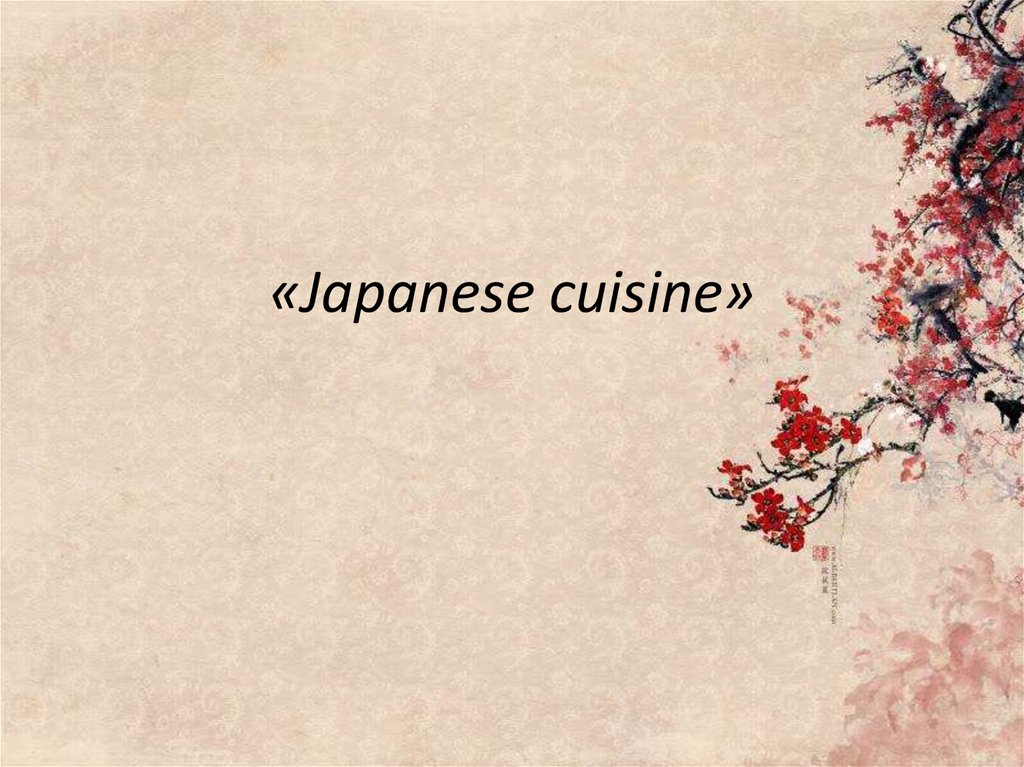Similar presentations:
Japanese cuisine
1.
«Japanese cuisine»2.
Japanese cuisine• Japanese cuisine is the national cuisine of the Japanese. It
differs by preference of natural, minimally processed
products, wide application of seafood, seasonality,
characteristic dishes, specific rules of registration of dishes,
serving, table etiquette. Japanese cuisine is usually a key
attraction for tourists from other countries.
3.
General characteristicThere are many opinions about what
defines Japanese cuisine, as the daily food
of the Japanese in recent centuries has
changed a lot, many dishes (for example,
which has become almost a national
Japanese dish ramen) appeared in Japan in
the late XIX-early XX century or even later.
In Japan, the term "Japanese cuisine" (YAP.
"Nihon Ryo:ri" or "waseku") refers to
traditional Japanese products similar to
those that existed before the end of
national seclusion in 1868.
The most characteristic features of Japanese
cuisine: The use of mainly fresh products,
necessarily of high quality. Virtually no
"long-term storage" products are used,
except for rice and sauces. A huge range of
seafood used for cooking. The desire to
preserve the original appearance and taste
of the ingredients in the dish (this does not
always apply to meat dishes). This Japanese
cuisine differs from most Asian, where the
products in the process of cooking often
change beyond recognition. Seasonality of
food. Focus on combining sweet with salty
and umami as a basic set of flavors in main
dishes. Small portion. The amount of food is
gained due to a greater variety of dishes,
not the size of the portions. Specific Cutlerymost dishes need to be eaten with
chopsticks, some can be eaten with hands,
spoons are rarely used, forks and knives are
not used at all. For this reason, most dishes
are served as
4.
Rice• Is the main ingredient of Japanese cuisine and the basis of food in
Japan. In Japanese, the word "gohan" (YAP. 御飯, boiled rice), like the
Russian "bread", means not only a specific food product, but also
food in General. For Japanese cuisine, rice varieties are preferred,
characterized by increased stickiness when boiling-when cooking from
such rice, the dish has a structure of small lumps, which are
convenient to eat with the help of sticks. Rice is prepared as a
separate dish and is used as a component in the preparation of many
"combined" dishes.
5.
Seafood• Fish, shellfish, marine
animals in Japanese
cuisine are the second
most important
component after rice. As
a rule, when cooking,
they are subjected to only
minor heat treatment
(roasting, steaming), and
some dishes (sashimi) are
included simply in raw
form. Used in Japanese
cuisine and seaweed.
6.
Noodle• Japanese cuisine uses
noodles:
ramen-from wheat flour
with the addition of eggs
(and / or alkaline mineral
water " Sansui»);
Udon-from wheat flour
without eggs;
soba — from buckwheat
flour (more often-with
the addition of wheat).
7.
Meat• Meat (beef and pork) came to
Japanese cuisine quite late
from European and Chinese.
Meat is a part of many
dishes, usually borrowed, for
example, ramen is often
served with a piece of pork
tyasyu. In many dishes, meat
is used in the form of
extremely thinly sliced slices
(not thicker than 1 mm),
which greatly reduces the
cooking time and preserves
the taste and aroma of meat.
8.
Rice dishSushi (sushi) Despite the fact that
historically this dish was a way of preserving
fish in fermented rice (which was then
thrown away), rice is now considered the
main component of sushi. Unlike ordinary
boiled rice, sushi rice is prepared in a
special way, in slightly salted water with
dried seaweed, to create a characteristic
umami flavor. After cooking, the slightly
cooled rice is poured with a special
sweetened rice vinegar, and then
intensively cooled with air flow (historically
fanning, nowadays often with an electric
fan), while constantly gently stirring, so that
the seasoning forms a dried film on the
surface of the rice grains. When rice
acquires a glossy appearance and cools
down to the possibility of painlessly taking it
in hand, it is ready for further use: modeling
nigiridzushi, twisting rolls (makizushi), etc.
9.
Salads
The Japanese make salads from a variety of
products: vegetables, fruits, mushrooms, rice,
noodles, fish, seafood, poultry and meat.
Moreover, they try either to avoid heat
treatment at all, or to make it minimal, which
preserves the ingredients: their natural
composition, odors, nutritional properties[2].
As a dressing, rice vinegar, soy sauce or sake
are usually used: for example, namasu salad
consists of carrots and daikon cut into thin
strips, salted and seasoned with sweetened rice
vinegar. Also in Japanese salads add a variety of
spices: dried seaweed, ground or pickled
ginger, ground black or allspice and grated
nutmeg. In addition to traditional salads, such
as gomaae (blanched greens with sesame
dressing) or kimpira-gobo (boiled in sweet soy
sauce burdock root with carrots) in Japanese
cuisine is widespread under the influence of
European cuisine version of vegetable salad.
10.
Soup• Traditional for Japanese cuisine is considered soup
"misoshiru." Its main ingredients are dark and light miso
paste (made from fermented soybeans) and
concentrated fish broth "hondashi". The rest of the
ingredients can vary in taste, it can be shiitake
mushrooms, wakame seaweed, tofu soy cheese, and
various types of meat and fish.
11.
Japanese cuisine also includes thefollowing soups:
butajiru/tonjiru— misoshiru with pork;
mangazero - soup with Dango, seaweed, tofu, Lotus root,
other vegetables;
imoni— stewed Taro root, a popular autumn dish in the
Northern regions of the country;
Zoni— soup with mochi with vegetables and, sometimes,
meat, most often his eat on a new Year;
ODEN - winter soup of boiled eggs, daikon, konnyaku,
stewed in clear Dashi broth with soy sauce;
Siroco— soup from adzuki, in which add mochi, portrayed
on new Year;
suimono - transparent soup with a basis of Dasi with the
addition of soy sauce and salt.











 cookery
cookery








